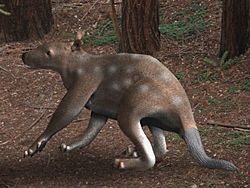Ekaltadeta facts for kids
Quick facts for kids EkaltadetaTemporal range: Oligocene to Pleistocene
|
|
|---|---|
 |
|
| Scientific classification | |
| Kingdom: | |
| Phylum: | |
| Class: | |
| Infraclass: | |
| Order: | |
| Family: |
Hypsiprymnodontidae
|
| Subfamily: |
Propleopinae
|
| Genus: |
Ekaltadeta
Archer & Flannery, 1985
|
| Species | |
|
|
Imagine a giant, meat-eating rat-kangaroo! That's what the Ekaltadeta was. This amazing animal lived in Australia many millions of years ago. It was a type of marsupial, which means it was a mammal with a pouch, just like modern kangaroos and koalas.
Contents
Meet the Ekaltadeta
The Ekaltadeta was a unique creature. Unlike most kangaroos today, which eat plants, the Ekaltadeta was a carnivore. This means it hunted and ate other animals. Scientists believe it might have used its strong jaws and teeth to crush bones or tear meat.
What Did It Look Like?
While we don't have a complete skeleton, fossils suggest the Ekaltadeta was quite large. It was much bigger than the rat-kangaroos we see today. It likely had powerful legs for hopping, similar to other kangaroos, but its teeth were very different. Its teeth were sharp and designed for a meat-based diet.
When Did It Live?
The Ekaltadeta lived for a very long time! Its fossils show it existed from the late Oligocene period, about 25 million years ago. It survived through the Miocene and Pliocene epochs. It finally died out around 50,000 years ago, during the Pleistocene epoch. This means it lived alongside some of Australia's other giant prehistoric animals.
Where Did It Live?
Fossils of the Ekaltadeta have been found in northern Australia. The most important discovery site is called Riversleigh, located in Queensland. Riversleigh is famous for its rich fossil beds, which tell us a lot about ancient Australian wildlife. This area was likely a lush, forested environment when the Ekaltadeta roamed.
Images for kids
See also
 In Spanish: Ekaltadeta para niños
In Spanish: Ekaltadeta para niños


